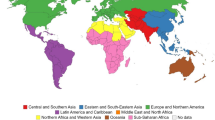Abstract
To demonstrate the importance of Arctic studies in the humanities and social sciences, we collected data from the SSCI and A&HCI covering a period of over 100 years and focused on the number of papers published each year, the major journals, types of documents, major languages represented, authors and their countries publishing the most articles, author’s affiliations, collaboration and the major research subjects covered. The results indicate that worldwide scholars had never been absent in this field for more than one century. Countries near the Arctic, particularly in North America and the Nordic, show the most interest and have the most research results. Universities and colleges are the most important research institutions in this field. North America is the area that has conducted the largest amount of research, while some Western European countries such as Germany and France, performed with great enthusiasm research in relation with North Pole expeditions. Arctic research in the humanities and social sciences has gradually expanded from the historical, archaeological, and anthropological fields to the realm of political, social, educational sciences including international relations, music, art, etc.



Similar content being viewed by others
Notes
The database chosen for this research covers the data retrospectively from early 1898, but the data meeting the topics of this paper begins from 1900.
References
Bayer, M. (2007) Who owns the Arctic. http://byers.typepad.com/arctic.
Bornmann, L., & Daniel, H. D. (2007). What do we know about the h index? Journal of the American Society for Information Science and Technology, 58(9), 1381–1385.
Bornmann, L., Schier, H., Marx, W., & Daniel, H.-D. (2011). Does the h index for assessing single publications really work? A case study on papers published in chemistry. Scientometrics, 89(3), 835–843.
Brent, L. J. N., Lehmann, J., & Ramos-Fernandez, G. (2011). Social network analysis in the study of nonhuman primates: A historical perspective. American Journal of Primatology, 73(8), 720–730.
Creswick, N., & Westbrook, J. I. (2010). Social network analysis of medication advice-seeking interactions among staff in an Australian hospital. International Journal of Medical Informatics, 79(6), e116–e125.
Egghe, L., & Rousseau, R. (1990). Introduction to Informetrics. Amsterdam: Elsevier.
Hirsch, J. E. (2005). An index to quantify an individual’s scientific research output. Proceedings of the National academy of Sciences of the United States of America, 102(46), 16569–16572.
Ikenberry, G. John. (2010). Who owns the Arctic? Understanding Sovereignty disputes in the North. Foreign Affairs, 89(2), 154–155.
Lotka, A. J. (1926). The frequency distribution of scientific productivity. Journal of the Washington Academy of Sciences, 16(12), 317–323.
Otte, E., & Rousseau, R. (2002). Social network analysis: A powerful strategy, also for the information sciences. Journal of Information Science, 28(6), 441–453.
Pao, M. L. (1985). Lotka’s law: A testing procedure. Information Processing and Management, 21(4), 305–320.
Parker, R. D., & Madjd-Sadjadi, Z. (2010). Emerging legal concerns in the Arctic: Sovereignty, navigation and land claim disputes. Polar Record, 46(239), 336–348.
Rousseau, B., & Rousseau, R. (2000). LOTKA: A program to fit a power law distribution to observed frequency data. Cybermetrics, 4(1). http://cybermetrics.cindoc.csic.es/articles/v4i1p4.pdf.
Schmidt, C. W. (2010). Cold hard cache: The Arctic drilling controversy. Environmental Health Perspectives, 118(9), A394–A397.
Shelton, R. (2010). The scramble for the Arctic: Ownership, exploration and conflict in the far north. The Times Literary Supplement, 5585, 26–27.
Smol, J. P., & Douglas, M. S. V. (2007). From Controversy to consensus: making the case for recent climate change in the Arctic using lake sediments. Frontiers in Ecology and Environment, 5(9), 466–474.
Wasserman, S., & Faust, K. (1994). Social network analysis: Methods and applications. In M. Granovetter (Ed.), Structural analysis in the social sciences (p. 825). Cambridge, MA: Cambridge University Press.
Young, O. R. (2009). Whither the Arctic? Conflict or cooperation in the circumpolar north. Polar Record, 45(232), 73–82.
Zhang, X., Guo, P. Q., Lin, X. L., Yan, Q. D., & Tu, J. F. (2009). Study on the economic status of the Arctic states and its characteristics. World Regional Studies, 18(1), 34–41. (text in Chinese).
Acknowledgments
Research for this article is funded by the Chinese Arctic and Antarctic Administration (Grants IC2010003 and JDZX20110405-GP-3-4). I would also like to express my gratitude to Ronald Rousseau (KHBO, Belgium) and David A. Hales, Professor Emeritus, University of Alaska Fairbanks for their advice while completing this paper.
Author information
Authors and Affiliations
Corresponding author
Rights and permissions
About this article
Cite this article
Hua, W., Yuan, S., Yan, M. et al. A quantitative analysis of Arctic related articles in the humanities and social sciences appearing in the world core journals. Scientometrics 91, 703–718 (2012). https://doi.org/10.1007/s11192-012-0690-0
Received:
Published:
Issue Date:
DOI: https://doi.org/10.1007/s11192-012-0690-0




